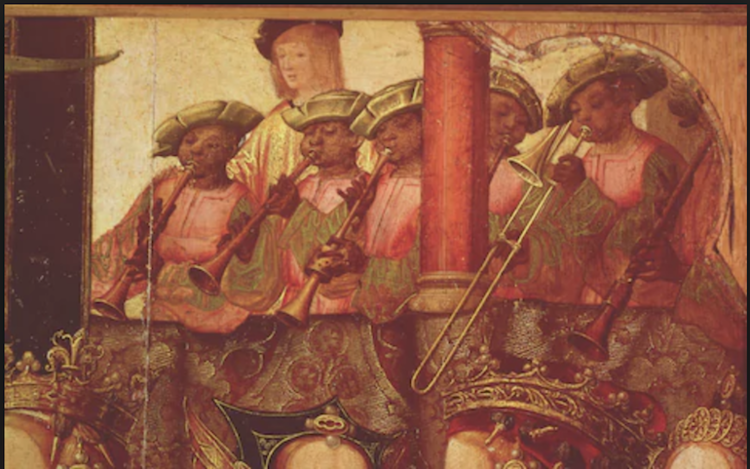The Undisclosed History of Black Tudors
The Tudor period was between 1485 -1603. To put this era into perspective consider a few major figures and events of the time. Christopher Columbus was serving up insurmountable destruction on the “New World”. The Transatlantic Slave trade was born. Michelangelo paints the Sistine Chapel. Henry VIII, well you know; doing the absolute most. Niccolo Machiavelli writes The Prince, The Art of War, amongst others. And Elizabeth I becomes queen.
The Engagement Of St. Ursula And Prince Etherius, Detail Of The Black Musicians, C.1520
Were there Black Tudors?
Absolutely, yes! Tudor England as it turns out was not lacking in diversity as we have been led to believe. The conception of Black people only settling in Britain during the 20th Century, the Windrush being the most highlighted so-called influx, is a complete misrepresentation of history. The question should not be ‘were there any Black Tudors?’ Instead, how many Black Tudors lived in Britain? And records show hundreds, possibly a thousand free Black people lived and contributed to Tudor society.
Black people were residing and earning a living in Tudor England. Working at many levels of society. The majority were servants, (cooks, gardeners, laundry women) a respectable profession, but there were others, such as entertainers who would dance and play music for the aristocracy. A quite famous Black Tudor was royal trumpeter John Blanke who was known to earn three times the wage of an average servant. A 60-foot-long vellum manuscript commissioned by Henry VIII sees Blanke sitting on a horse, with a trumpet in his hand and a turban around his head.
Who was John Blanke?
John Blanke, is the unwitting poster boy for the Black Tudors (although his image is a caricature). Not a lot is known about Blanke but it is believed he came to London around 1501 as one of the African attendants of Catherine of Aragon.
John Blanke was a trumpeter and was hired by Henry VII to play in his court. A surviving document from the accounts of the Treasurer of the Chamber records a payment of 20 shillings to "John Blanke the blacke trumpet" as wages for the month of November 1507, with payments of the same amount continuing monthly through the next year. He also successfully petitioned Henry VIII for a wage increase.
Dr Sydney Anglo was the first historian to propose that the "blacke trumpet" in the 1507 court accounts was the same as the Black man depicted twice in the 1511 Westminster Tournament Roll. The Westminster Tournament Roll is an illuminated, 60-foot-long manuscript now held by the College of Arms; it recorded the royal procession to the lavish tournament held on 12 and 13 February 1511 to celebrate the birth of a son, Henry, Duke of Cornwall (d. 23 February 1511), to Catherine and Henry VIII on New Year's Day 1511. John Blanke is depicted twice, as one of the six trumpeters on horseback in the royal retinue.
Black Tudors: Untold Story
A great example of the ordinary lives of Black Tudors is illustrated in historian Miranda Kauffman’s book, Black Tudors:The Untold Story. Kauffman brings to life the lives of 10 characters, whose skills made them valued, integrated members of their community, they included a silk weaver, salvage diver and merchant.
Nothing screams integration like interracial relationships. Parish records show interracial marriages, for example in 1599 in St Olave Hart Street, John Cathman married Constantia "a Black woman and servant". A bit later, James Curres, "a moore Christian", married Margaret Person, a maid. Dr Onyeka Nubia, author of The Blackamoores:Africans in Tudor England provides an in-depth evidenced based look at the era and just how Africans made Britain a home for themselves.
Portrait of a Moor, c1525-30 (Jan Mostaert)
Who was the first known Black Tudor?
There are not any records to show who the first Black Tudor was but we do know how they arrived in Great Britain. A great deal of Black people came via Portuguese trading ships with enslaved Africans onboard. Others came with merchants or from captured Spanish ships.
England had not yet established itself as a superpower, coloniser. The superpowers of the time were Portugal and Spain. In 1562, Captain John Hawkins, on behalf of Elizabeth I made his first slaving voyage to Africa. Making a further three voyages over six years. It was not until the early 1600s that they really ramped up their slave enterprise. On England soil, however, it was forbidden by law for anyone to be a slave.
London could definitely be seen as a metropolis, even then it was the most diverse city in England. Immigrants from France, Spain, Italy and Portugal came to London in their thousands, with approximately 1000 Africans living across England. The city grew from 50,000 in 1500 to 200,000 a century later. To state the obvious, assimilation was easier for the Europeans, the Africans were an easy target for a city under strain. Tolerance towards Black people became a notable issue as documented in the Cecil papers in 1601.
"The queen is discontented at the great numbers of 'negars and blackamoores' which are crept into the realm since the troubles between her Highness and the King of Spain, and are fostered here to the annoyance of her own people."
Remembering Black Tudors
It’s unlikely Black people were all in Britain by choice, but we were definitely here and present in society nonetheless. Black presence grew to approximately 20,000 by the 1800s, largely due to the end of slavery. There were even prominent and celebrated figures such as Cesar Picton, Olaudah Equiano and Ignatius Sancho who enjoyed wealth and influence. To say it is time to change the narrative of this nation's history is an understatement. The omission of the greater story, which it definitely is, is damaging and deliberate. History is much richer in its truest form.



